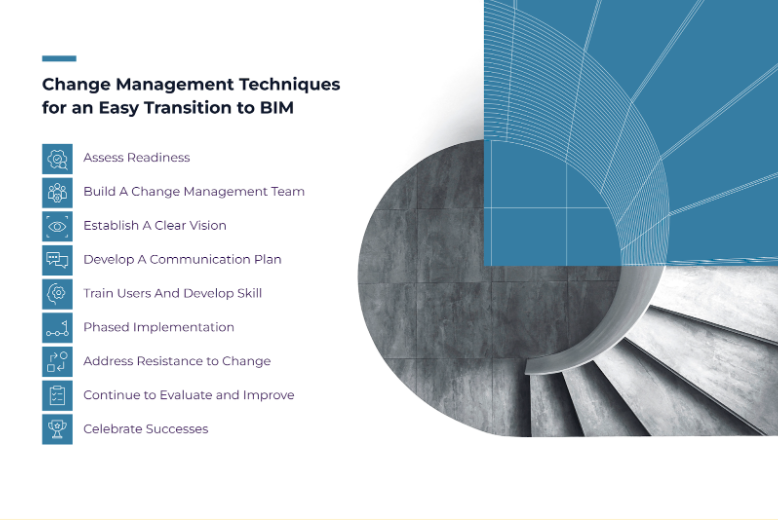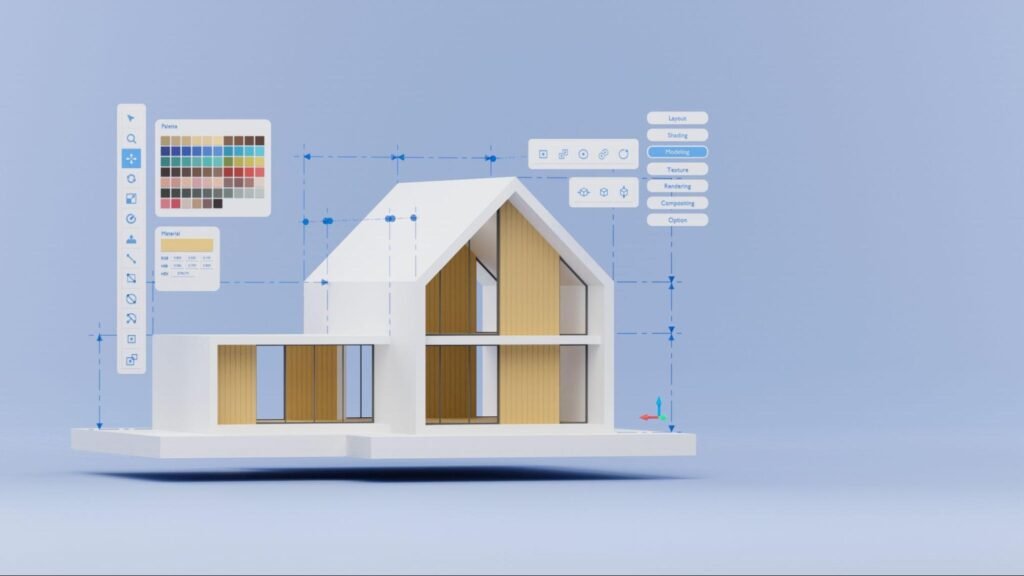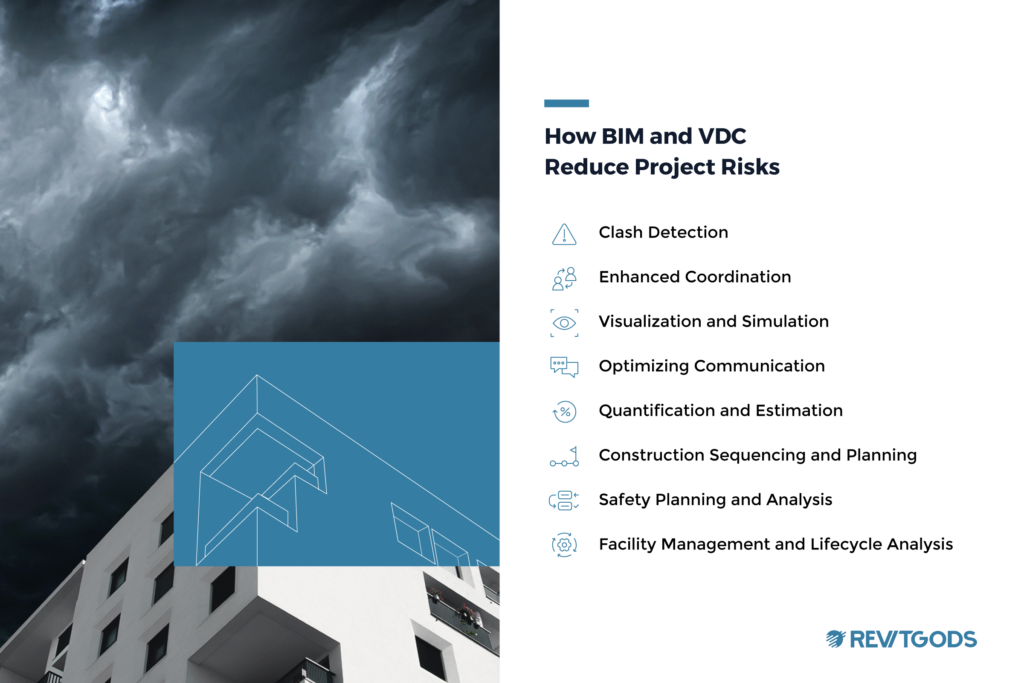In today’s fast-paced architectural, engineering, and construction industries, building information modeling (BIM) is transforming the way projects are conceived, executed, and supervised.
BIM implementation goes beyond simply embracing technology; it requires a methodical approach that guarantees the organization is prepared, stakeholders are involved, functionality is assessed, and BIM seamlessly integrates into existing workflows. Change management plays a significant role in effectively implementing BIM by addressing both digital and organizational transformations.
While investments of both time and money in the change management process may seem substantial, the advantages BIM brings to the design and construction project process make them worthwhile.
Change Management Techniques for an Easy Transition to BIM
When transitioning to BIM, it’s important to have effective change management strategies to achieve a smooth and successful implementation. The following strategies and techniques can help your organization overcome the challenges associated with adopting BIM and maximize this technology’s potential benefits.
1. Assess Readiness
Evaluating your organization’s readiness for the BIM transition is crucial for a smooth team adoption process. Here are some important methods and considerations to help assess your organization’s preparedness for such changes:

- Conduct a gap analysis: Perform a comprehensive assessment of your organization’s current practices, workflows, and capabilities in relation to BIM implementation. Identify any gaps between existing design processes and the desired BIM workflows.
- Evaluate technological infrastructure: Review your organization’s technological infrastructure to confirm BIM compatibility. This may involve upgrading hardware, checking software compatibility, or enhancing network capabilities to handle large BIM models.
- Assess staff skills and training: Evaluate your design team members’ skills and identify any training needs in BIM-related areas. Provide training on software, 3D modeling, visualization, and data management to ensure your staff is proficient in using BIM tools.
- Evaluate data management practices: Assess your organization’s data management practices for BIM compatibility. Improve data standards, file naming conventions, version control, automation and real-time updating, and data security to optimize the BIM workflow for smooth information exchange.
- Engage stakeholders: Involve key stakeholders, such as project managers, executives, and end-users, in the assessment process. Gather their feedback and insights to better understand your organization’s readiness for BIM adoption.
- Seek external expertise: Consider seeking advice from external architecture, engineering, and construction (AEC) industry consultants or BIM experts who can provide an impartial assessment and guidance on necessary improvements.
Remember to periodically review and update the assessment as your organization progresses in its BIM implementation.
2. Build a Change Management Team
Creating a dedicated project team for the BIM transition brings focused expertise, clear accountability, and improved project coordination through the implementation lifecycle.
Consider the following roles and responsibilities when assembling your change management team:
- BIM manager: This role oversees the entire BIM process, including strategy development, resource allocation, and coordination with stakeholders. They set goals, track progress, and successfully integrate BIM into existing workflows.
- Change management specialist: This designates the person who develops change management plans and supports communication and training initiatives. They address resistance, manage expectations, and ensure the smooth adoption of BIM across the organization.
- Technical lead: The technical lead manages the technical aspects of BIM implementation. They handle software selection, hardware requirements, cloud-based needs, and data management. They collaborate with IT teams to ensure seamless integration of BIM tools and establish data exchange and collaboration protocols.
- Training coordinator: The training coordinator develops and delivers training programs for team members on BIM tools, design processes, and workflows. They assess training needs, create training materials, and provide ongoing support to facilitate a smooth transition to BIM.
- Communication and stakeholder engagement lead: This role develops and implements a communication strategy to engage and inform stakeholders about the benefits and progress of the BIM transition. They gather feedback, address concerns, and promote a positive perception of BIM technology within the organization.
3. Establish a Clear Vision
Setting clear goals, objectives, and expectations for the BIM transition is essential for success. These goals serve as guiding principles for effective communication, change management efforts, and continuous improvement throughout the entire transition process. Examples of clear goals might include:
- Reduce project documentation time by 30% in two years
- Improve employee retention by 20% in two years
- Reduce project RFIs and change orders by 50% in two years
- Become an industry leader in building sustainability in five years
- Complete 90% of all projects on time and under budget in five years
These goals set a holistic view for the company that a transition to BIM can be a major part of.
4. Develop a Communication Plan
Effective communication will help inspire innovation and drive successful BIM adoption within your organization. Clear and transparent communication fosters an inclusive environment by informing stakeholders about the transition’s progress and benefits. A few places to start include:
- Engaging stakeholders through workshops and training sessions to create a sense of ownership and encourage buy-in
- Addressing concerns and building support, alleviating resistance, and creating a collaborative environment
- Establish regular information sharing to promote continuous learning and improvement
5. Train Users and Develop Skills
Evaluating skills gaps and offering comprehensive BIM training are vital for the effective use of BIM. These strategies support BIM adoption, maximize its benefits for project delivery and collaboration, and minimize the need for design changes and other change orders. To effectively train your team, you should:
- Assess skills gaps through tests or surveys to select comprehensive training programs
- Offer ongoing support and guidance, including access to BIM-related resource libraries and knowledge centers
- Continuously offer professional development opportunities, such as attending conferences or organizing knowledge-sharing sessions, so your users and design teams stay up-to-date with BIM advancements
6. Phased Implementation
Introducing BIM through pilot projects is a smart way to optimize workflows before implementing it on a larger scale. This approach minimizes disruption, reduces risks, identifies design change management processes, and maximizes the advantages of BIM. Here’s how to get it right:
- Select a small-scale project or department as a pilot, allowing teams to experiment, test software, and identify challenges
- Provide thorough training and share knowledge with design teams to help them succeed
- Evaluate and receive feedback on processes to refine them
- Gradually expand BIM adoption to larger projects or departments to leverage the lessons learned
7. Address Resistance to Change
Recognizing and addressing resistance is necessary for successfully adopting BIM. A proactive approach helps build understanding and trust and facilitates a smoother transition. This enables BIM to maximize its potential to improve project outcomes. A few tips for success include:
- Anticipate potential resistance by gathering stakeholder feedback
- Communicate the benefits of using BIM and debunk misconceptions
- Provide ongoing training and support
- Engage stakeholders through involvement and recognition
- Establish cross-functional teams or working groups with representatives from different departments to collaboratively address challenges, share experiences, and develop effective strategies for BIM adoption
8. Continue To Evaluate and Improve
Setting metrics to track the progress of BIM implementation provides a data-driven approach for informed decision-making and continuous improvement in BIM adoption. Here are some ways to do this:
- Define key performance indicators (KPIs) aligned with goals, such as cost management or error reduction
- Collect data using BIM software or project management tools
- Regularly evaluate performance against KPIs
- Gather stakeholder feedback for improvement
- Continuously refine workflows and compare with industry benchmarks
9. Celebrate Successes
Acknowledging achievements in the BIM transition is important for fostering motivation, reinforcing commitment, and promoting a positive culture of BIM adoption. A few ways to celebrate successes include:
- Celebrate milestones
- Acknowledge employee efforts
- Share case studies and success stories
- Seek industry recognition
Both internal and external recognition plays a significant role in building confidence and support for BIM adoption. Furthermore, external recognition can attract clients and partners who recognize your organization’s BIM expertise, opening doors to new opportunities for growth and success.
Embracing BIM Transformation
Your successful transition to BIM relies on effective change management strategies. Embrace BIM as more than just a technological change. It’s a profound shift in processes and collaboration, and recognizing this will ensure a successful transition and enable your organization to fully benefit from this digital transformation.
Have a question about BIM? Our experts can answer a wide spectrum of questions about BIM implementation, Autodesk’s Revit, standards, and any other BIM-related issues.





